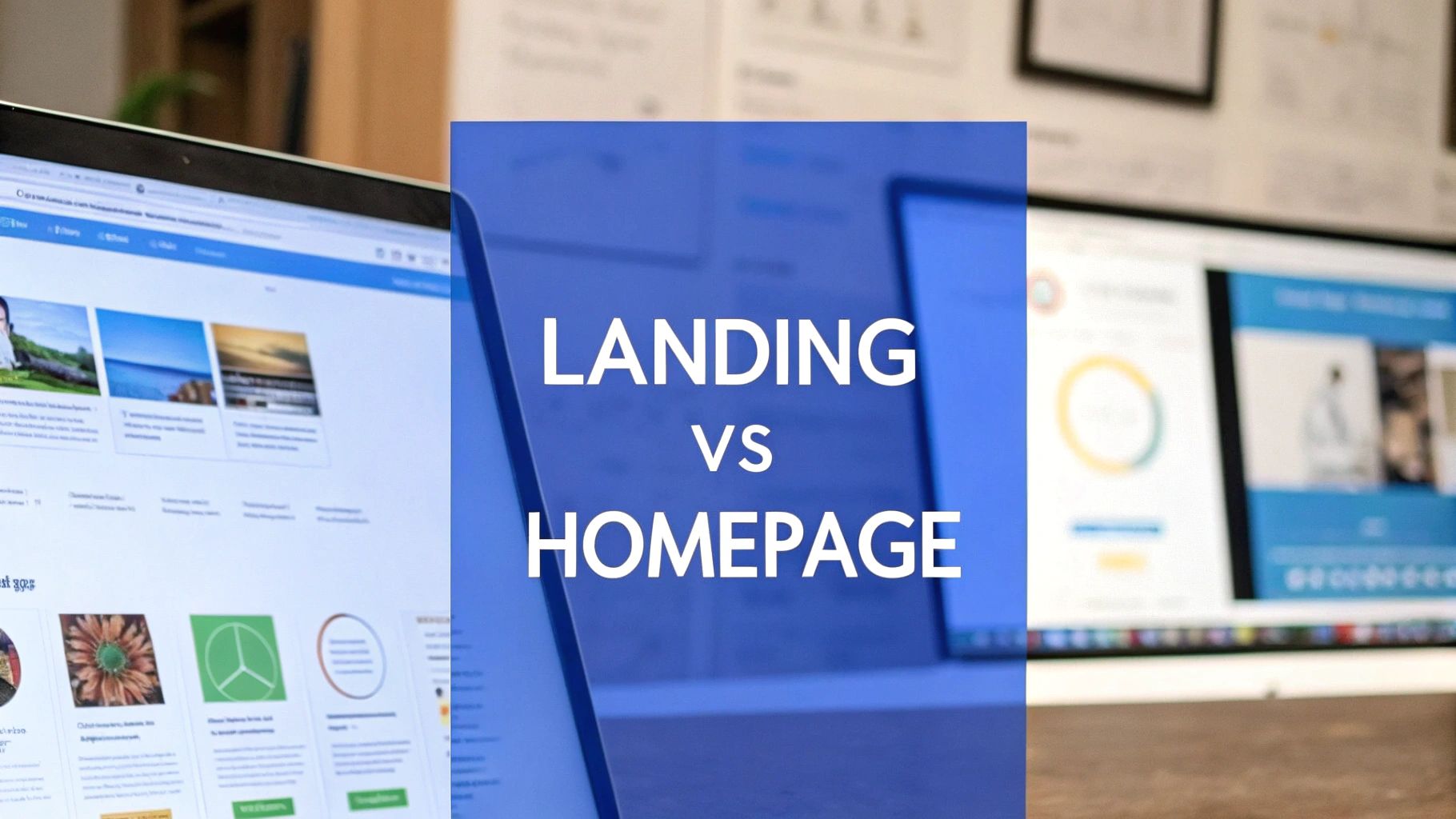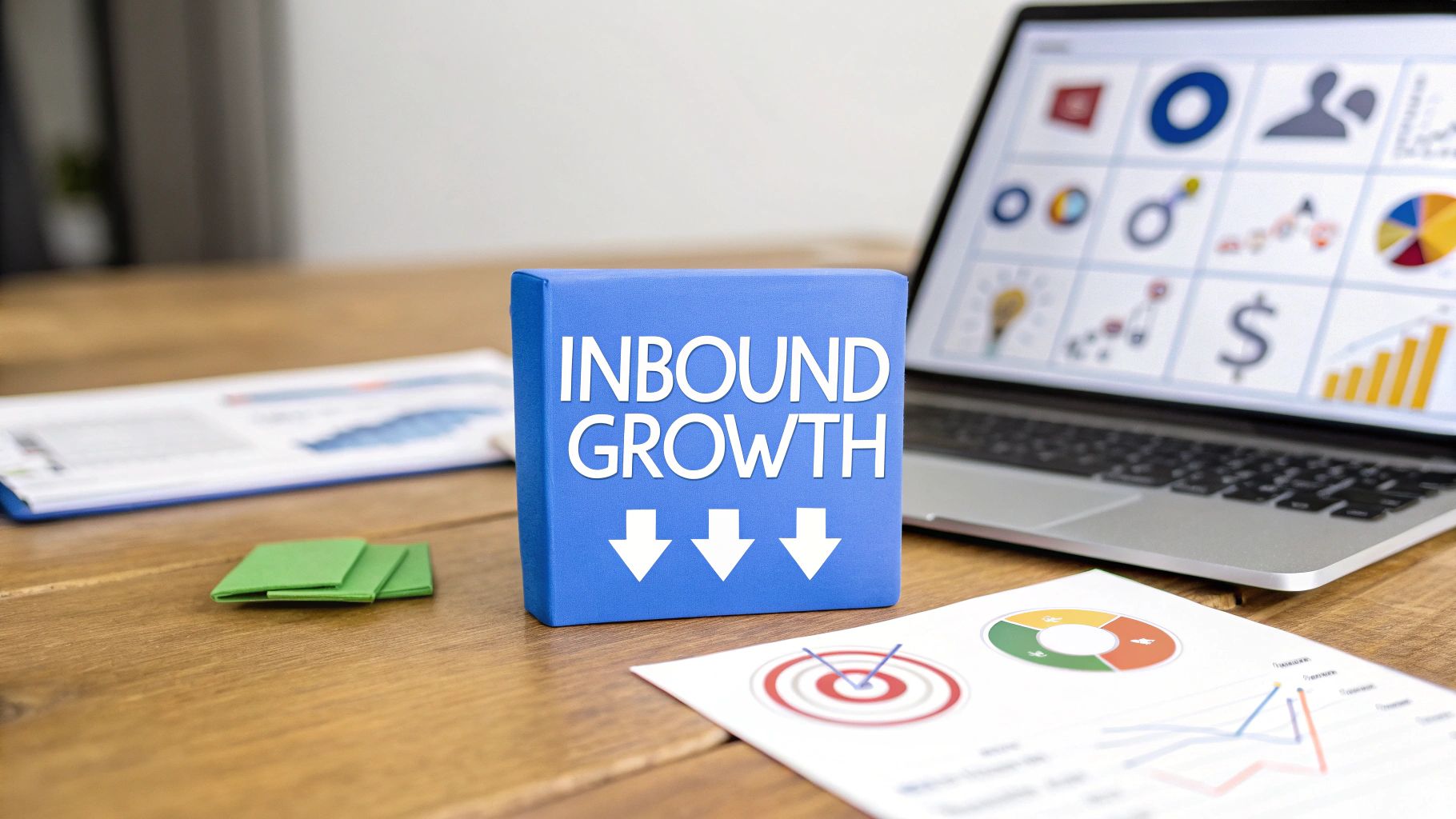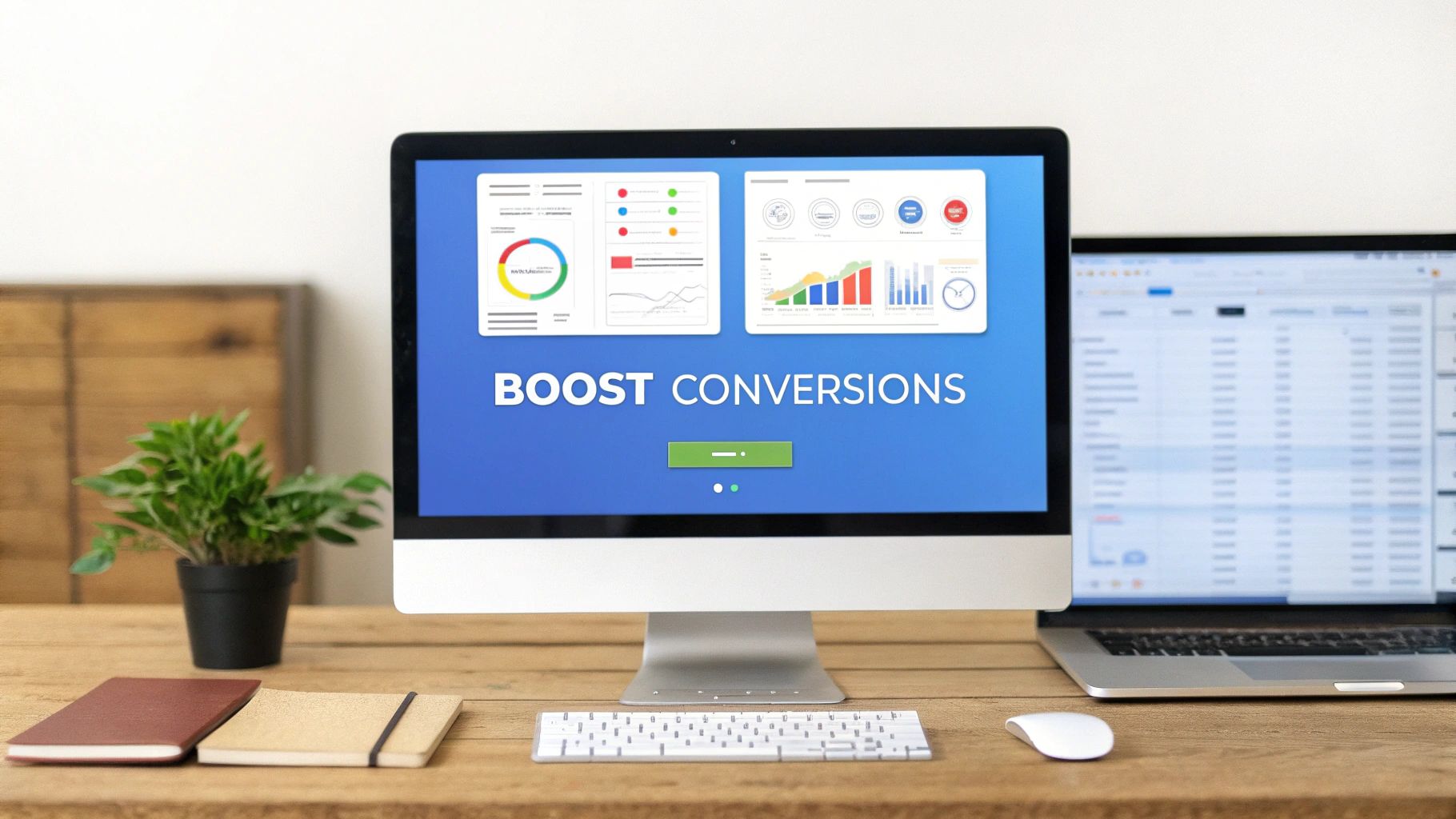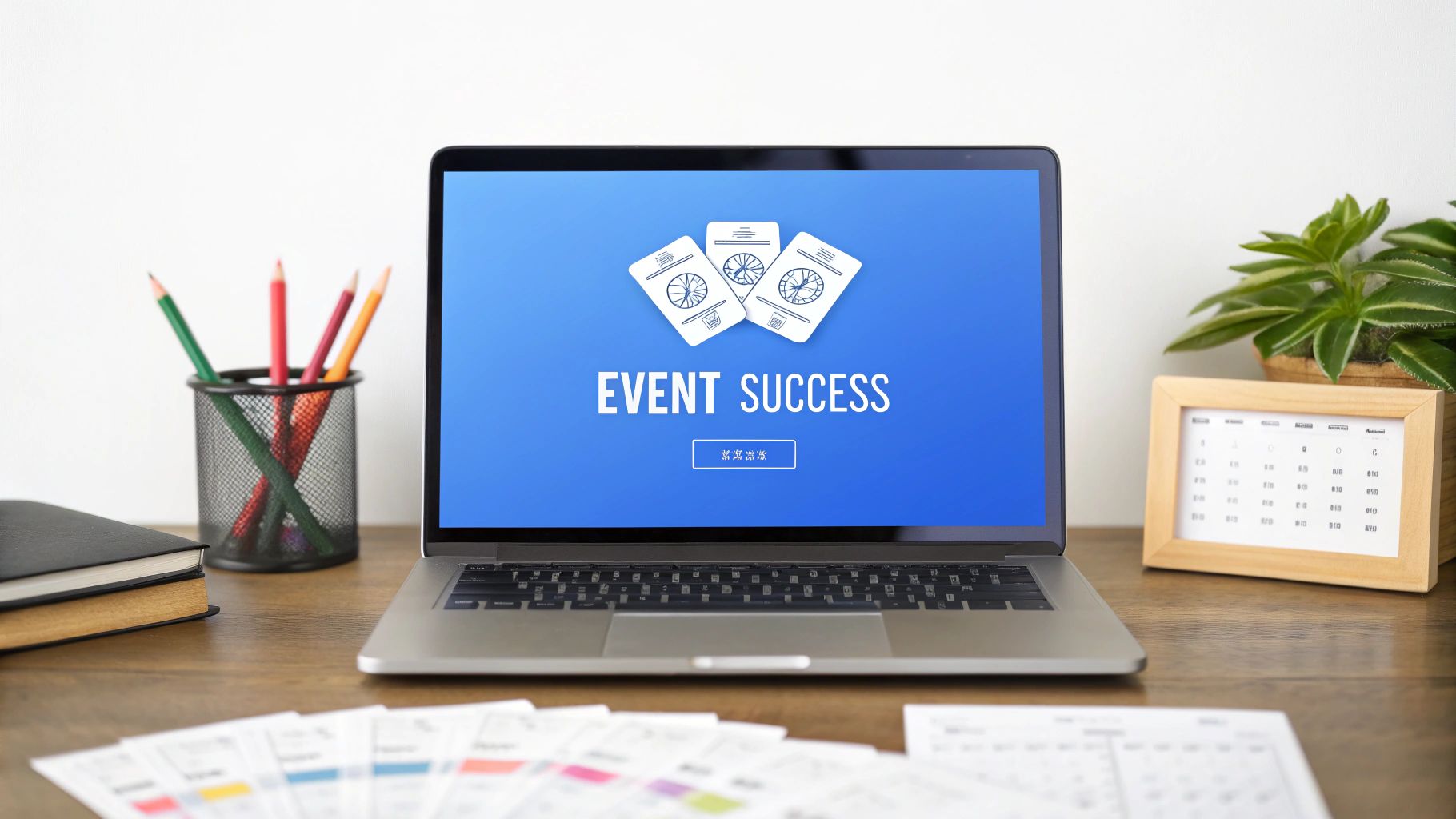Summary
When you boil it down, the real difference between a landing page and a homepage comes down to one thing: intent. Your homepage is the digital front door to your business, built for exploration and giving visitors a broad overview. A landing page, on the other hand, is a specialist. It’s a focused, standalone page built for a single, specific action, like getting someone to sign up after clicking an ad.
But which one should you use for your next campaign? Understanding their unique roles is the key to driving results.
Understanding The Core Differences

Here's a simple analogy. Think of your homepage as the friendly receptionist in a large office building. Their job is to welcome everyone, offer general information, and point people in the right direction—whether that's sales, support, or the company blog. It’s a central hub designed to serve a diverse audience with different goals.
A landing page is more like an express checkout lane at the grocery store. It has one job: get a specific person to complete a specific action as efficiently as possible. That "action" could be anything from signing up for a webinar to downloading an ebook or requesting a product demo.
Key Functional Distinctions
The entire design and structure of each page is dictated by its core function. A homepage is built to encourage browsing and brand discovery. A landing page is engineered to convert. Plain and simple.
This singular focus is exactly why most high-converting landing pages have no main navigation menu. By removing links that lead to other parts of your site, you eliminate distractions and keep the visitor's eyes on the prize: the call-to-action (CTA). Your homepage, by necessity, is the complete opposite—it’s loaded with links to guide users deeper into your site.
A homepage’s goal is to inspire exploration and build brand trust. A landing page’s goal is to drive a specific action. Confusing the two is one of the most common—and costly—mistakes in digital marketing.
Understanding the unique role each page plays is fundamental to building a marketing funnel that actually works. Once you grasp what conversion is in marketing, it becomes obvious why you need a specialized page to achieve it.
Homepage vs Landing Page At a Glance
To make the distinction crystal clear, here’s a quick side-by-side breakdown of their key characteristics. This table highlights how their purpose, traffic sources, and design elements differ to meet their distinct goals.
As you can see, they're two completely different tools for two completely different jobs. Are you using the right one for your campaigns?
Anatomy of an Effective Homepage
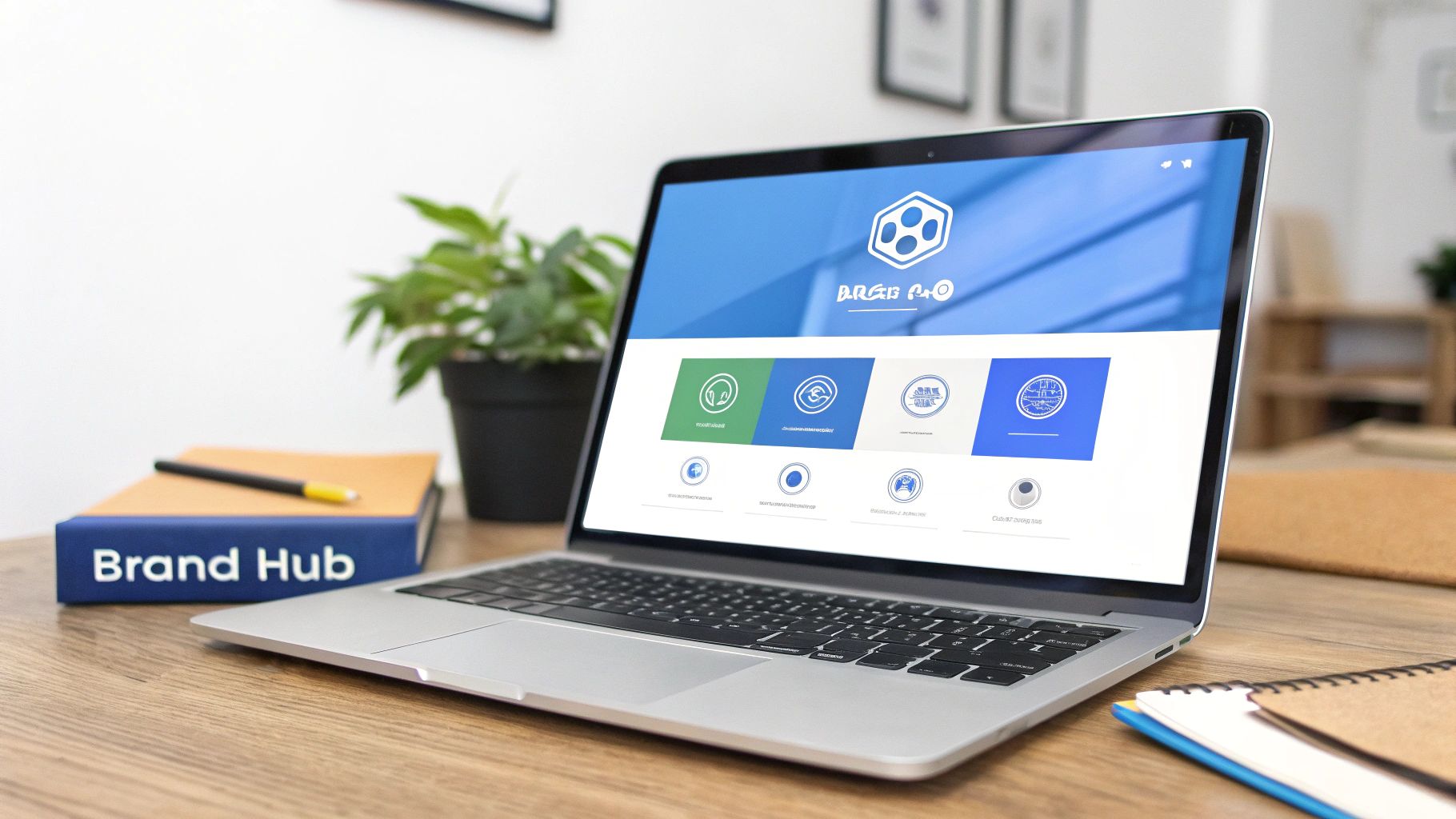
Think of your homepage as your brand’s front door. It’s the digital welcome mat for everyone, from first-time visitors who are just curious to loyal customers coming back for more. Each person arrives with a different goal.
Unlike a laser-focused landing page, a homepage isn't built to force a single conversion. Its real job is to build trust, show off your brand’s personality, and act as a helpful guide, pointing people where they need to go.
A great homepage is a master of directing traffic. Some visitors are looking for your contact info, others want to see what you sell, and some just want to read your latest blog post. The homepage has to serve all these needs at once without becoming a cluttered mess. This is a huge differentiator in the landing page vs homepage conversation—a landing page is a sprint to a single finish line, while a homepage is the starting point for a choose-your-own-adventure marathon.
Core Components That Build Trust
To do its job right, a homepage needs a few key elements working in harmony. These are the building blocks that establish your credibility and make it simple for people to find their way around. A solid structure is everything; it’s what keeps visitors from hitting the back button.
Here’s a look at the non-negotiables for any strong homepage:
- Clear Brand Messaging: Your headline and subheadline must instantly answer three questions: Who are you? What do you offer? And who is it for? No jargon, no fluff.
- Intuitive Navigation: The main menu should be logical and easy to follow. It’s the roadmap to your most important pages, like "Services," "About Us," and "Contact."
- Multiple Calls-to-Action (CTAs): A homepage needs more than one CTA. You’ll have different CTAs to guide various types of visitors to their next step, like "Explore Our Products" for browsers or "Read Our Case Studies" for researchers.
- Social Proof: Nothing builds trust faster than seeing that other people already trust you. Client logos, testimonials, and case studies provide instant validation. In fact, 89% of consumers say they check reviews before buying, so this is essential.
For a great real-world example, take a look at the videobgremover.com homepage. It does a fantastic job of acting as a central hub for its services. The site immediately communicates what it does and gives users clear paths to explore its features, orienting them quickly and efficiently.
Designing for Exploration and Guidance
At its core, homepage design is all about creating a great user experience that encourages people to stick around and explore. It should feel like a friendly guide, not a pushy salesperson. This is where a well-planned layout and visual hierarchy come into play, drawing the eye to the most important areas.
A well-designed homepage strikes a perfect balance between providing information and guiding action. It tells your brand’s story, shines a spotlight on your best offerings, and offers obvious next steps for every kind of visitor.
Your homepage is the starting point of a conversation. It should make a great first impression and invite visitors to learn more, rather than demanding an immediate commitment.
Ultimately, you want visitors to feel confident and comfortable as they click through your site. Every single element should contribute to a smooth journey, whether they’re on a mission to find something specific or just window shopping. This foundation of trust is what turns a casual visitor into a loyal customer.
Deconstructing the High-Converting Landing Page
While a homepage is your digital storefront, built for broad exploration, a high-converting landing page is a finely tuned machine. It's an environment engineered around a single, specific objective: getting a visitor to take one action. This "one page, one purpose" philosophy is exactly what makes it such a potent conversion tool.
Think about it. When someone clicks your ad for a "free e-book on social media marketing," what do they expect? Dumping them on a homepage cluttered with links to your blog, services, and company history creates instant confusion. A dedicated landing page, on the other hand, meets that expectation head-on, reinforcing the ad's promise and guiding them smoothly toward the download.
This direct line between the ad's promise and the page's content is called message match. It’s a make-or-break concept in the landing page vs. homepage discussion because it has a massive impact on user experience and, ultimately, your conversion rates. Strong message match tells visitors they’re in the right place, building immediate trust and slashing bounce rates.
The Anatomy of a Conversion Machine
A truly effective landing page isn't just a collection of elements thrown together; it's a carefully orchestrated system. Every single component works in harmony to persuade and convert. What you remove is often just as important as what you add.
Here are the non-negotiable components that make a landing page click:
- A Compelling Headline: This is your first—and sometimes only—shot. The headline must instantly connect with the ad the visitor just clicked, clearly stating the value they'll get.
- Benefit-Oriented Copy: Don't just list features. Your copy needs to spell out how your offer will solve a problem or make the visitor's life better. Keep the language clear and direct.
- A Singular Call-to-Action (CTA): This is the heart of the page. There should be only one main button or link, with punchy, action-oriented text like "Download Your Guide" or "Start My Free Trial."
- Distraction-Free Design: This is crucial. Most top-performing landing pages have no main site navigation. By stripping away links to other pages, you create a closed loop that funnels all of the user's attention toward the one action you want them to take.
This focused approach pays off. Data consistently shows that dedicated landing pages outperform other conversion methods. In fact, landing pages can deliver a 160% higher conversion rate than other signup forms. The global average conversion rate for a landing page hovers around 26%—a world away from the typical 1-2% you might see on a homepage.
Psychological Triggers That Drive Action
Beyond the basic structure, great landing pages lean on proven psychological principles to nudge visitors toward action. They tap into predictable human behaviors to make the offer more irresistible and the decision to convert feel like a no-brainer.
These psychological drivers are woven right into the page's design and copy.
A landing page isn't just a web page; it's a persuasive argument. It presents a problem, offers a solution, and makes it incredibly easy to say "yes."
For example, displaying testimonials or customer logos is classic social proof, playing on our natural tendency to trust what others are already doing. Creating scarcity with a limited-time offer triggers a sense of urgency, compelling people to act now rather than later. When building your pages, it is crucial to apply these techniques correctly. Our guide on how to optimize landing pages provides actionable steps for implementing these powerful strategies.
Ultimately, the goal is to make the conversion feel like the obvious next step. To get the most out of any page—be it a homepage or a landing page—it's vital to implement Conversion Rate Optimization (CRO) best practices. Every element, from the hero image to the color of the CTA button, must be intentionally chosen to support that singular goal, making the landing page an indispensable tool for any targeted marketing campaign.
When to Use a Homepage vs a Landing Page
Figuring out where to send your traffic isn't a minor detail—it's a critical decision that can make or break your campaign's success. You turn clicks into customers by sending the right visitor to the right page at the right time. The whole landing page vs homepage debate isn't about which one is better, but which one is right for the job.
Think of it like choosing a tool. You wouldn't use a sledgehammer for a task that needs a scalpel. Your homepage is your versatile, all-purpose tool, while your landing page is a precision instrument designed for one specific cut.
Your homepage is the perfect destination for traffic that’s just exploring. When someone searches your brand name or wants to get a feel for who you are, the homepage gives them the comprehensive overview they need. It’s your central hub for building brand awareness and trust.
On the other hand, a landing page is your go-to for any campaign with a single, measurable goal.
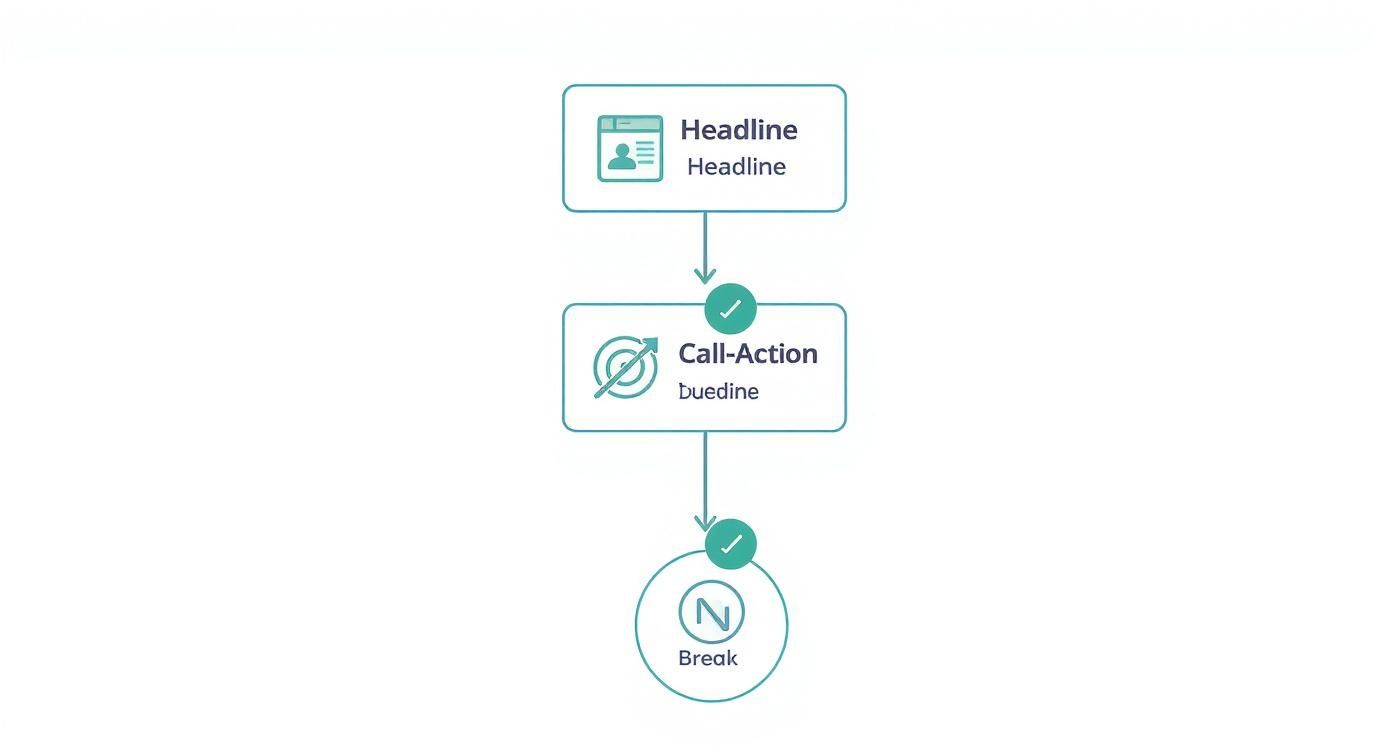
The real takeaway here is that a landing page's power comes from its laser focus. Every single element on the page exists for one reason: to drive a conversion. So, when is it the right choice?
When Your Homepage Is the Best Choice
Your homepage shines when a visitor's intent is broad or still undefined. It's the ideal welcome mat for organic traffic, direct referrals, and anyone curious about your brand as a whole. Its job is to greet, orient, and guide them.
You should be sending traffic to your homepage in these scenarios:
- Organic Brand Searches: When someone types your company name into Google, they're looking for your front door. Your homepage is the most logical and user-friendly destination.
- General Awareness Campaigns: If you're running a PR campaign or a broad social media push to introduce your brand, the homepage gives new visitors the full picture.
- Company Announcements: For major news like a merger or rebranding, the homepage provides crucial context within your broader brand identity.
- Facilitating Exploration: For visitors who aren't ready to commit but want to browse products, read your blog, or check the "About Us" page, the homepage is the perfect launchpad.
In these situations, the goal isn't an immediate conversion; it's about building a relationship and providing information. The homepage’s rich navigation and multiple CTAs are strengths here, offering a choose-your-own-adventure that caters to diverse interests.
Sending highly targeted ad traffic to a homepage is like inviting a guest over for a specific meeting and then leaving them in the lobby to find their own way. It’s inefficient and often leads to confusion.
When a Landing Page Is Non-Negotiable
A landing page becomes essential anytime you have a specific offer and are driving traffic with a clear, singular purpose. It's the specialist you call in when the goal is a direct conversion, not general exploration. Using a landing page for targeted campaigns isn't just a good idea—it's a proven strategy for maximizing your ROI.
Use a dedicated landing page for these goals:
- PPC Ad Campaigns: This is the most common and critical use case. A landing page that mirrors your ad copy (this is called message match) will dramatically improve conversion rates and Quality Scores.
- Email Marketing Promotions: When you email your list about a special offer, send them to a page focused solely on that promotion. It eliminates distractions and drives action.
- Lead Magnet Downloads: Whether it’s an e-book, a whitepaper, or a webinar registration, a landing page is the most effective way to capture leads in exchange for your valuable content.
- Specific Product or Feature Launches: Announcing something new? A landing page can highlight its benefits and capture pre-orders or sales without the noise of your full website.
The data backs this up. For instance, the SaaS industry often sees landing page conversion rates around 9.5%, while email traffic can convert at an impressive median rate of 21%. One A/B test even found that a dedicated landing page achieved nearly three times the conversion rate of a homepage for the same offer. If you want to dive deeper, you can check out more details about these performance metrics to see just how important this choice is.
Choosing the Right Page for Your Campaign
To make this crystal clear, let's break down which page to use based on your campaign goals and traffic sources. This isn't about guesswork; it's about matching the user's intent with the right experience.
Ultimately, the decision comes down to one question: Is the user's intent focused or broad? A focused intent demands a landing page, while a broad intent is best served by a homepage. Getting this right is a foundational step toward building campaigns that don't just get clicks, but deliver real results.
How Your Choice Impacts Marketing ROI
Deciding between a landing page and a homepage isn't just a design preference—it's a financial one. This is especially true when you're paying to get people to your site. The right page can multiply your return on investment (ROI), while the wrong one will burn through your ad budget with almost nothing to show for it.
The real magic here is message match. It’s the seamless connection between what your ad promises and what your page actually delivers. If someone clicks an ad for "50% Off Winter Boots" and lands on a page all about that sale, the experience is smooth and intuitive. That kind of perfect alignment is exactly what advertising platforms like Google Ads are looking for.
Boosting Your Ad Performance
A strong message match directly pumps up your Quality Score, which is the metric Google uses to figure out how relevant your ad is. A higher Quality Score tells the platform that you're giving users a great, relevant experience.
This has a very real impact on your wallet:
- Lower Cost Per Click (CPC): Google literally rewards high Quality Scores with cheaper ad costs. You pay less for every single click because you’re making their users happy.
- Better Ad Positioning: Ads with high scores often get top spots, even if you're not bidding as much as a competitor.
- Higher Conversion Rates: It's just common sense. A focused page that keeps the promise from the ad will convert better. There are no distractions, just a clear path to taking the offer.
Now, imagine sending that same paid traffic to your homepage. The alignment is gone. The visitor now has to hunt around your entire site, trying to find the deal you promised them. This friction is a killer—most people will just leave, wasting your ad spend and signaling to Google that your page isn't a good match for your ad.
The Financial Case for Landing Pages
The data doesn't lie: investing in dedicated landing pages pays off. One A/B test directly compared an ad sending traffic to a landing page versus the same ad linking to a homepage. The results were stunning. The landing page brought in nearly three times the conversion rate, even with fewer clicks. Better yet, the campaign spend was $800 less for the landing page, and the cost per conversion was about one-third of the homepage's.
A homepage is built to welcome everyone; a landing page is built to convert a specific someone. In paid advertising, specificity is what generates profit.
This is the kind of efficiency that lets businesses scale. Just increasing your landing page count from 10 to 15 can boost leads by a massive 55%. Companies that have over 20 landing pages can see conversion lifts pushing 300%. These numbers show exactly how landing pages slash wasted ad spend by cutting out the noise and reinforcing the ad's core message. You can discover more about how landing page volume impacts lead generation and its effect on your bottom line.
It's critical to understand the direct line between your page choice and your campaign performance. It’s not about just getting clicks; it's about turning those clicks into profitable actions. To really get a handle on these crucial metrics, check out our detailed guide on the difference between ROI vs. ROAS in marketing.
Building a Cohesive Web Strategy
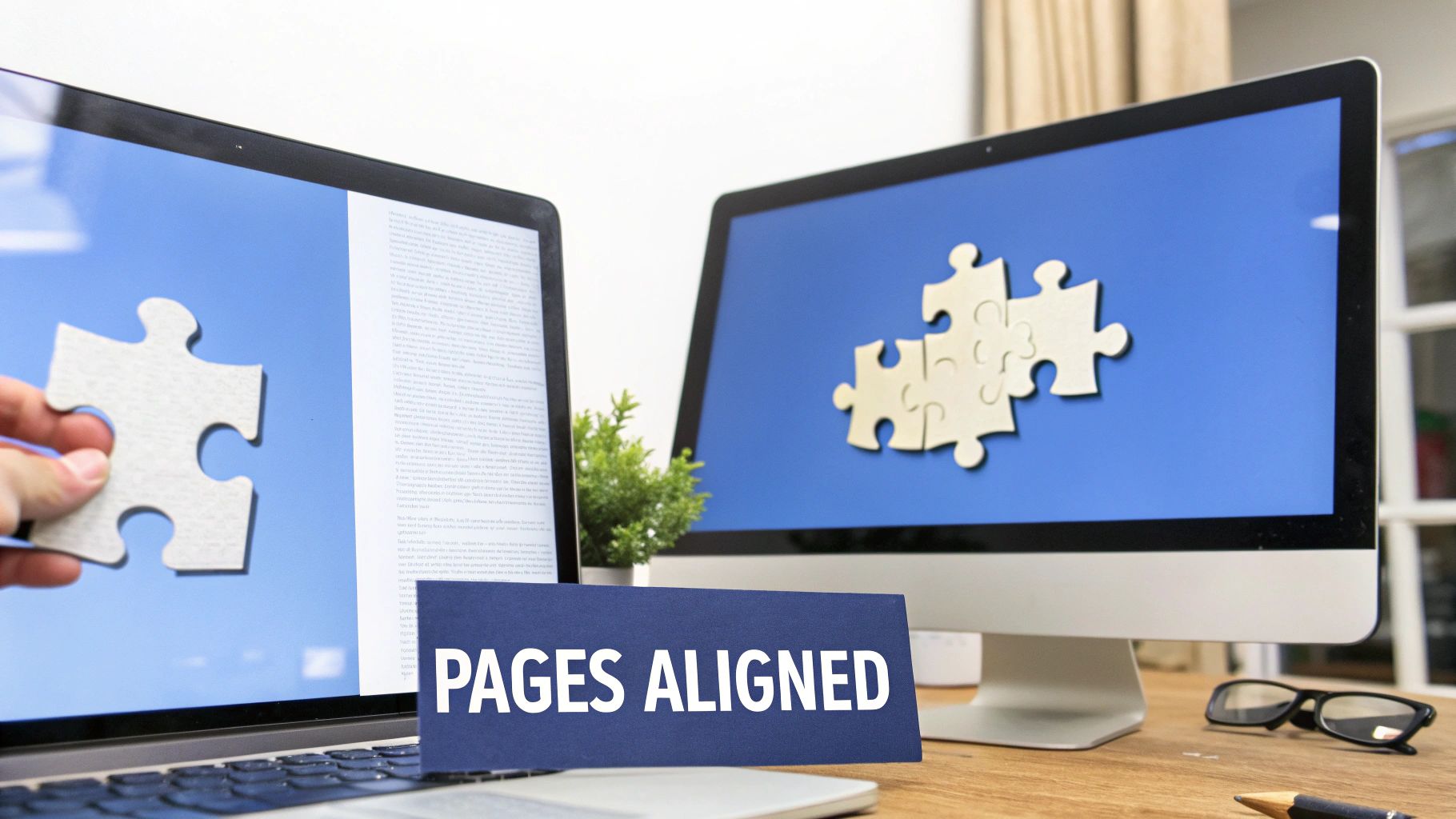
The whole landing page vs homepage debate misses the point. It’s not a competition. You need both. The sharpest web strategies use these two assets together, giving each one a distinct, vital role in guiding a customer from curiosity to conversion.
Think of it this way: your homepage is the foundation of your brand's digital presence, while landing pages are the targeted front doors for specific campaigns. When they work in harmony, you create a seamless experience that takes users from that first click all the way to long-term loyalty. It's about building an integrated system where every page has a job to do.
The Complete User Journey in Action
Let’s walk through a typical customer path to see how this partnership clicks. Imagine someone sees your Google ad for a "limited-time software discount."
Step 1: The Click. They hit the ad and are immediately sent to a dedicated landing page. This page is a perfect match for the ad's promise, with a bold headline about the discount, punchy copy focused on benefits, and one single, unmissable call-to-action: "Claim My Discount." The focused design makes it incredibly easy to convert.
Step 2: The Conversion. The offer is clear and compelling, so the user fills out the form. Just like that, you have a new customer. The landing page did its job perfectly—capturing a high-intent lead from a paid campaign.
Step 3: The Return Visit. A week later, that new customer wants to learn more about your company. They search your brand name and arrive at your homepage. Here, they can dig into your company’s mission, check out other products, or read your blog. The homepage is there to solidify the brand relationship that the landing page started.
This flow shows the perfect handshake. The landing page converts targeted traffic with ruthless efficiency, and the homepage steps in to nurture that new relationship for long-term engagement.
Maintaining Brand Consistency Across Pages
For this to work, brand consistency is non-negotiable. Even though a landing page must be free of distracting navigation, it must still feel like it belongs to your brand. Your logo, color scheme, and tone of voice should be identical across your homepage and every single landing page.
A landing page introduces a specific offer, but a homepage introduces your entire brand. Both must speak the same visual and verbal language to build trust and create a cohesive user experience.
Strategic linking helps, too. While you’ll strip the main navigation menu from a landing page, you can subtly link your logo back to the homepage. This gives curious visitors an exit route without pulling focus from the main CTA. By building this kind of integrated system, you ensure every interaction is purposeful, guiding users effectively whether they’re ready to buy now or just want to explore.
Frequently Asked Questions
Even with a good handle on the differences, specific questions always pop up. Let's tackle some of the most common ones to help you fine-tune your strategy.
Can a Landing Page Be a Homepage?
Technically, yes, but it's almost always a terrible idea. A landing page is stripped down for a single purpose, ditching site navigation and extra info to keep a visitor focused on one goal.
If that’s your homepage, anyone who arrives organically or just wants to explore your brand will hit a dead end. A homepage is your welcome mat and main directory; a landing page is a one-way street to a conversion. Mixing them up just frustrates visitors and tanks engagement.
Should I Use a Landing Page for SEO?
It depends on your goal. For broad, high-traffic keywords, you'll want to rank your core site pages like your homepage or product pages. They offer the comprehensive content that both users and search engines are looking for.
However, there's a place for "SEO landing pages." These are built to target very specific, long-tail keywords tied to a niche offer. Unlike a paid ad landing page that's completely locked down, an SEO landing page usually keeps some site navigation. This helps it rank better organically while still pushing visitors toward a specific action. The key is always to match the page type to what the searcher is trying to accomplish.
How Many Landing Pages Should I Have?
The short answer? As many as you need. A good rule of thumb is to create a unique landing page for every single campaign, ad group, or audience segment you're targeting.
Running three different ads for three different pain points? You should have three distinct landing pages that speak directly to each one.
The more landing pages you have, the more opportunities you create for targeted messaging. Businesses with 21 to 40 landing pages can see conversion increases nearing 300% compared to those with fewer pages.
This approach ensures a solid message match from ad to page, which is critical for getting the most out of your ad spend.
Can I Have Multiple Homepages?
No, a website has only one designated homepage. It’s the root URL of your domain (like yoursite.com) and the main entry point for your entire site. Trying to have more than one would just confuse your visitors and search engines.
You can—and should—create as many campaign-specific landing pages as you want, but you will always have just one central homepage to serve as the main hub.
Ready to stop wasting ad spend and start converting more clicks? LanderMagic lets you create dynamic, high-converting landing pages tailored to every ad campaign. Build pages that perfectly match user intent and watch your ROI climb.



